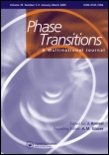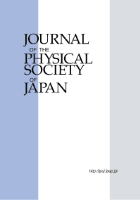
Progress in Superconductivity and Cryogenics
Scope & Guideline
Advancing the Frontiers of Superconductivity and Cryogenics
Introduction
Aims and Scopes
- Superconducting Materials and Properties:
Focuses on the synthesis, characterization, and enhancement of various superconducting materials, including high-temperature superconductors (HTS) and MgB2, investigating their physical properties and performance in different conditions. - Cryogenic Engineering and Applications:
Covers advancements in cryogenic technologies, including designs and evaluations of cryogenic systems, thermal storage units, and cooling techniques to support superconducting applications. - Magnetic Devices and Applications:
Studies the design and performance of superconducting magnets and related devices, including magnetic separation techniques, superconducting current limiters, and magnetic levitation systems. - Experimental Techniques and Measurements:
Explores various experimental methodologies for evaluating superconducting properties, including advanced characterization techniques like Raman spectroscopy, magnetization loss measurements, and tensile testing. - Theoretical and Computational Studies:
Includes theoretical investigations and computational modeling of superconducting phenomena, contributing to the understanding of superconductivity mechanisms and device optimization.
Trending and Emerging
- High-Temperature Superconductors (HTS):
There is a noticeable increase in research focused on high-temperature superconductors, particularly REBCO and MgB2, emphasizing their properties, applications, and enhancements through doping and novel processing techniques. - Integration of Superconductivity with Emerging Technologies:
Research exploring the integration of superconducting materials with technologies such as quantum computing, electric vehicles, and advanced medical imaging devices is on the rise, indicating a trend towards practical applications. - Sustainable and Efficient Cryogenic Systems:
There is growing interest in the design and optimization of cryogenic systems for energy storage and efficiency, reflecting a broader trend towards sustainability in technology. - Advanced Characterization Methods:
The use of sophisticated characterization techniques, including Raman spectroscopy and advanced imaging methods, is becoming more prominent, indicating a trend towards understanding the fundamental properties of superconductors at a deeper level. - Magnetic Separation Technologies:
Research into magnetic separation techniques, particularly for environmental applications such as microplastics removal and wastewater treatment, is gaining attention, highlighting the intersection of superconductivity with environmental science.
Declining or Waning
- Low-Temperature Superconductors:
Research related to low-temperature superconductors, particularly Nb3Sn and similar materials, has decreased, possibly due to the growing interest in high-temperature superconductors and their applications. - Basic Theoretical Research on Superconductivity:
Theoretical studies that do not directly relate to practical applications or experimental validations are less frequently published, suggesting a shift towards more applied research. - Cryogenic Fluid Dynamics:
Although important, the focus on the fundamental fluid dynamics of cryogenic fluids has diminished in favor of more application-oriented studies, such as the design of cryogenic systems.
Similar Journals

LOW TEMPERATURE PHYSICS
Illuminating the Science Beneath Absolute ZeroLOW TEMPERATURE PHYSICS, published by AIP Publishing, is a premier academic journal dedicated to the exploration and dissemination of research in the field of low-temperature physics. With an ISSN of 1063-777X and an E-ISSN of 1090-6517, this journal serves as a vital resource for researchers, professionals, and students eager to delve into the intricacies of thermal phenomena at reduced temperatures. Operating under a structured peer-review process, it presents high-quality, original research articles, reviews, and brief communications, all aimed at advancing our understanding of this specialized domain. Although it does not provide open access, the journal's presence in the Q3 category of Physics and Astronomy (miscellaneous) and its ranking within the 27th percentile reflect its commitment to impactful, cutting-edge research. With a publication timeline spanning from 1997 to 2024, LOW TEMPERATURE PHYSICS remains an essential platform for sharing innovative findings and fostering collaboration among physicists worldwide.

npj Quantum Materials
Elevating the Standards of Quantum Materials Researchnpj Quantum Materials is a premier, peer-reviewed academic journal published by NATURE PORTFOLIO, focusing on the transformative field of quantum materials. Launched in 2016, this open-access journal aims to bridge the gap between theoretical advances and experimental discoveries, providing a platform for researchers to share cutting-edge findings in condensed matter physics and materials science. With a prestigious Q1 ranking in both Condensed Matter Physics and Electronic, Optical and Magnetic Materials, it stands out in its field, boasting impressive Scopus rankings—#34 out of 434 in Condensed Matter Physics and #39 out of 284 in Electronic, Optical and Magnetic Materials, putting it in the 92nd and 86th percentiles, respectively. The journal emphasizes collaborative efforts that drive innovation and application in quantum technologies, making it an essential resource for researchers, professionals, and students eager to contribute to this rapidly evolving discipline. Accessible to a global audience, npj Quantum Materials continues to shape the future of quantum research through its high-quality publications and community engagement.

Journal of Superhard Materials
Innovating the future of materials science with superhard solutions.The Journal of Superhard Materials, published by PLEIADES PUBLISHING INC, is a premier journal dedicated to advancing the field of superhard materials, including their synthesis, properties, and applications. With an ISSN of 1063-4576 and E-ISSN 1934-9408, this journal serves as an essential resource for researchers and professionals focused on material science and inorganic chemistry. As of 2023, it ranks in the Q3 category for both Inorganic Chemistry and Materials Science (miscellaneous), establishing its growing significance within the scientific community. The journal, located in the United States at PLEIADES HOUSE, New York, welcomes submissions that contribute innovative findings in the realm of superhard materials, fostering collaboration and knowledge exchange among scholars. Researchers interested in cutting-edge developments and applications in this niche area will find valuable insights and findings published in this journal, encouraging continued exploration and discovery in the materials sciences.

Journal of Superconductivity and Novel Magnetism
Transforming Ideas into Innovations in MagnetismJournal of Superconductivity and Novel Magnetism, published by SPRINGER, is a premier venue for research in the dynamic fields of condensed matter physics and materials science. With an ISSN of 1557-1939 and an E-ISSN of 1557-1947, this journal provides an essential platform for disseminating innovative studies examining the complexities of superconductivity and magnetic phenomena. The journal is recognized for its contributions, holding a Q3 quartile ranking in both condensed matter physics and electronic, optical, and magnetic materials as of 2023. With a commitment to rigor and relevance, it features research that breaks new ground in understanding the properties and applications of superconducting materials, aiming to bridge fundamental science with technological advancements. Despite its lack of open access, the journal remains pivotal for researchers, professionals, and students keen to stay abreast of cutting-edge developments in the field, making it an indispensable resource for cultivating knowledge and promoting collaboration.

Superconductivity
Empowering breakthroughs in superconductivity and beyond.Superconductivity is a prestigious open-access journal published by Elsevier, dedicated to advancing the field of superconductivity and its applications across various domains. Launched in 2022, this journal has quickly established itself as a pivotal platform for researchers and professionals, earning a distinguished Q1 ranking in multiple categories including Condensed Matter Physics, Electrical and Electronic Engineering, Electronic, Optical and Magnetic Materials, and Energy Engineering and Power Technology. Researchers can access the journal freely, promoting broad dissemination of innovative research findings to a global audience. With a significant focus on multidisciplinary approaches, the journal encourages submissions that explore the theoretical, experimental, and practical aspects of superconductivity. Given its high visibility and the rigorous peer-review process, Superconductivity is an essential resource for those aiming to contribute to the cutting-edge advancements in this transformative field.

Condensed Matter
Advancing Knowledge in Condensed Matter PhysicsCondensed Matter is a leading open-access journal dedicated to the diverse and dynamic field of condensed matter physics, published by MDPI since 2016. With its base in Switzerland, the journal aims to present a platform for researchers and professionals to share innovative findings and advancements in areas such as electronic, optical, and magnetic materials. As of 2023, it is ranked in the Q3 category for both condensed matter physics and electronic, optical, and magnetic materials, a testament to its relevance and growth within the scientific community. Researchers will find valuable insights through its accessible format, fostering collaboration and knowledge dissemination within this interdisciplinary field. With a commitment to enhancing the global dialogue in condensed matter studies, Condensed Matter invites contributions that explore theoretical and experimental approaches, thus pushing the boundaries of understanding in this crucial area of science.

PHASE TRANSITIONS
Illuminating Innovations in Material PropertiesPHASE TRANSITIONS is a prominent academic journal, published by Taylor & Francis Ltd, dedicated to advancing the field of phase transition phenomena across various materials and systems. With a history spanning from 1979 to 2024, this journal provides a vital platform for researchers to share their findings on the intricate behaviors of materials under different conditions, particularly in the domains of Instrumentation and Materials Science. Despite its current Q3 category ranking in both fields, PHASE TRANSITIONS plays a crucial role in pushing the boundaries of these areas, offering insights that contribute to significant innovations. Although it does not operate as an Open Access journal, its content can be accessed through various academic databases, ensuring that important research is available to the community. As reflected by its standing in Scopus rankings, researchers and practitioners alike will find the studies published in this journal to be relevant and impactful in broadening their understanding of material properties and behaviors.

IEEE Magnetics Letters
Unveiling Breakthroughs in the World of MagneticsIEEE Magnetics Letters, published by IEEE-INST ELECTRICAL ELECTRONICS ENGINEERS INC, is a leading journal focusing on the rapidly evolving field of magnetics, encompassing electronics, optics, and magnetic materials. With an ISSN of 1949-307X and an E-ISSN of 1949-3088, this journal serves as a premier platform for researchers to disseminate innovative findings, discussions, and reviews from 2010 to 2024. Recognized for its contribution to the field, it is classified in the third quartile (Q3) of Electronic, Optical and Magnetic Materials, and it holds a respectable place in Scopus rankings, positioned #189/284 in its category. Although it operates under traditional access options, the journal remains vital for professionals and academics seeking to deepen their understanding of magnetics and its applications in modern technology. With its commitment to advancing knowledge and fostering innovation, IEEE Magnetics Letters continues to be an invaluable resource for those engaged in cutting-edge research.

Optoelectronics and Advanced Materials-Rapid Communications
Accelerating Discoveries in Optoelectronic Innovations.Optoelectronics and Advanced Materials-Rapid Communications is a pivotal journal in the field of optoelectronics, specializing in the rapid dissemination of original research and reviews concerning advanced materials and their applications. Published by the NATL INST OPTOELECTRONICS in Romania, this journal has been instrumental for researchers and professionals since its inception in 2008. With an E-ISSN of 2065-3824, it offers a platform for innovative studies across various disciplines, focusing on both theoretical and practical advancements in electrical and electronic engineering, as well as electronic, optical, and magnetic materials. Although currently categorized in the Q4 quartile based on the 2023 Scopus rankings, the journal is dedicated to enhancing its visibility and citation impact among the scientific community. By facilitating open access to cutting-edge research, Optoelectronics and Advanced Materials-Rapid Communications not only addresses the needs of emerging scholars and industry professionals but also contributes to the broader discourse on materials science. As it continues to evolve through 2024 and beyond, the journal remains an essential resource for those committed to advancing knowledge in optoelectronic technologies.

JOURNAL OF THE PHYSICAL SOCIETY OF JAPAN
Fostering Global Collaboration in Physical ResearchThe JOURNAL OF THE PHYSICAL SOCIETY OF JAPAN, published by the Physical Society of Japan, has been at the forefront of advancing knowledge in the field of Physics and Astronomy since its inception in 1946. With a commendable reputation reflected in its Q2 ranking within its category for 2023, this journal serves as a vital platform for disseminating high-quality research and innovative concepts. Researchers and professionals alike can engage with cutting-edge studies and reviews that span a diverse range of topics pivotal to the physical sciences. Although the journal does not currently operate with an open access model, it maintains a robust impact on the global physics community, evidenced by its placement in the 59th percentile among a competitive pool of 243 journals. With an unwavering commitment to bridging theory and application, the JOURNAL OF THE PHYSICAL SOCIETY OF JAPAN continues to inspire and cultivate scholarly discourse and collaboration across disciplines.